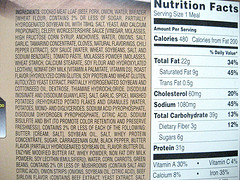Panel Suggests Energy Star-Like Labeling System For Sugar, Fats & Sodium In Food
When you inspect the nutrition info on a package of food, it provides all sorts of information — grams of sugar and fat, milligrams of sodium — but consumers may not know exactly whether those numbers are high or low. That’s why a U.S. Institute of Medicine — at the behest of Congress and the Centers for Disease Control — has suggested a rating system for food that is not unlike the Energy Star system used for appliances.
“[I]t is time for a fundamental shift in strategy,” writes the panel, “a move away from systems that mostly provide nutrition information without clear guidance about its healthfulness, and toward one that encourages healthier food choices through simplicity, visual clarity, and the ability to convey meaning without written information.”
The panel also concluded that such a clear and concise system “should motivate food and beverage companies to reformulate their products to be healthier and encourage food retailers to prominently display products that meet this standard.”
To that end, the panel suggests a front-of-package system that, like Energy Star ratings, immediately let the buyer know what they’re buying.
It came up with four criteria for the system:
Simple: not requiring specific or sophisticated nutritional knowledge to understand the meaning
Interpretive: nutrition information provided as guidance rather than as specific facts
Ordinal: offering nutritional guidance by using a scaled or ranking system
Supported by communication: with readily remembered names or identifiable symbols
Thus, the label would display calories in common household measure serving sizes. For bulk items like fruits and vegetables, this information would be placed on the shelf.
The label would also show — on a scale from 0-3 — the number of nutritional “points” (for saturated and trans fats, sodium, and added sugars). The higher the number of points, the healthier it is.
A rep for the Institute explained the point system to Consumerist:
There’s a 2-step process for earning points, the eligibility step and the qualifying step.
Step 1, the eligibility step, is to ensure that shoppers won’t be misled. To be eligible to earn points, a product cannot be too high in sodium or saturated fat – meaning it can’t contain more than 20% of the Daily Value of these nutrients. And it cannot be one of the products listed in USDA’s category called Sugars, Sweets and Beverages, which are products with high amounts of added sugars. There are some products that contain really high levels of either added sugars or sodium or saturated fats but low levels of other nutrients of concern.
For example, most of us would agree that a lollipop shouldn’t appear to be a healthy food even though it has low-to-no sodium and saturated fat. Given its high content of added sugar, it would be ineligible in our system to earn symbols on its wrapper representing low sodium and low saturated fat.
So once you’ve determined the product meets the eligibility criteria, then you go to step 2, the qualifying step, and use another set of criteria to determine how many points a product can earn. The qualifying criteria are generally more stringent.
The report has proposed ways for FDA to determine what the appropriate threshold levels for qualifying criteria should be, but it is up to the agency to set those thresholds. If a product has less than the qualifying threshold amount of say sodium, it can get a point for sodium that would be represented on the package with an icon. It’s up to FDA to determine what the icon should be.
Want more consumer news? Visit our parent organization, Consumer Reports, for the latest on scams, recalls, and other consumer issues.


